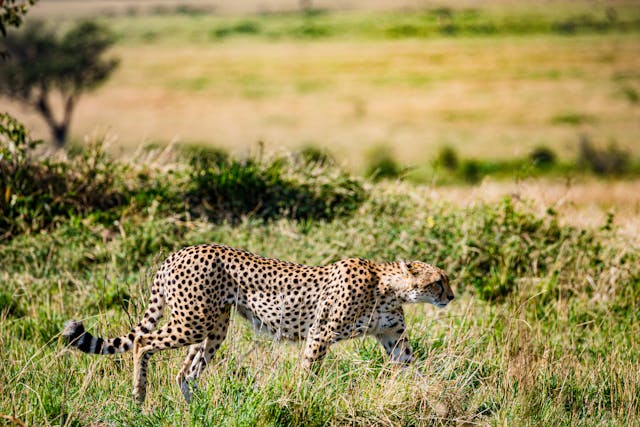
How does a cheetah run so fast? It is a combination of their body weight, their claws, their spine, their joints, the type of muscles they have, their tail, their organs, and the size of their head and skeleton.
Cheetahs are the fastest land animals. They have a top speed of approximately 113 km/h and can accelerate to this speed in 3 seconds. That is faster than most regular cars you will be able to buy. They are not the fastest animals on Earth. The peregrine falcon can reach 300 km/h, but it can only do this in a dive, where it has aerodynamic advantages. The fastest flying animal is a Brazilian free-tailed bat, which can fly at 160 km/h. The cheetah is also beaten by the black marlin, which is a fish that has been clocked at 132 km/h. However, as land animals go, the cheetah is by far the fastest. So, how can a cheetah run so fast?
They are animals that are adapted for speed, and they have evolved to be as fast as they possibly can. The first adaptation they have is their body weight. If you look at a fast sports car, there is always a balance between the weight of the car and the amount of power you can supply. The heavier the car is, the more power it needs to go faster, which means the heavier the engine has to be, and so on. If the car is lighter, it doesn’t need as much power to go faster, and the engine can be smaller. F1 companies are always trying to shave kilograms off their cars for this reason. The cheetah is a very light big cat. In fact, they are one of the lightest of all the big cats, because speed is more important than muscle mass.
The second adaptation is their claws. All cats, except for the cheetah, have retractable claws. This ability protects the claws, but it slightly reduces grip. Cheetahs’ claws don’t retract, which increases the grip they have with the ground. Again, looking at F1 cars, more grip equals more speed. Cheetahs have impressive grip, but they also have a very high stride cadence which brings their gripping paws into contact with the ground more than other animals. At top speed, they take 4 strides a second. Each time they impact the ground, they are imparting more force and picking up more speed. Greyhounds, for comparison, only take about 3 strides a second.
The third adaptation is their spine and joints. If you look at human sprinters, longer strides tend to be faster than shorter strides. Usain Bolt’s stride length is about 2.5 m. That is pretty impressive, but a cheetah’s stride length is 7.6 m, over three times longer. This is made possible because of their spines and joints. When they hit the ground between a stride, their spine compresses, like a spring, picking up energy. When they push off, their spines stretch out completely, releasing this energy. No other animal can stretch out so far when they run. As well as this, their leg joints are flexible, which allows them to spread out and increase the length of their strides.
The fourth adaptation is the type of muscles they have. If an animal wants to run fast, it needs to have muscles that can contract very quickly. However, the animal also needs to have muscles that can contract a long way. Small animals tend to have muscles that can contract very quickly, but they cannot contract very far because they are too small, which limits their speed. Large animals have muscles that can contract very far, but not very quickly. That limits their speed. Cheetahs have evolved to be right at the point where the speed their muscles can contract is balanced by how far they can contract, giving them peak speed. If they have faster contracting muscles, they will lose depth, and if they have greater depth, they will lose speed, either way slowing them down. This is the main reason why cheetahs are the weight they are.
The fifth adaptation is their tail. Travelling at the speeds they do, they need to be able to turn and to balance. Cats use their tails to balance and when they jump, but cheetahs windmill their tails to counterbalance themselves so they can balance and turn at speed. They have very long tails that are the same length as their bodies.
The sixth adaptation is their organs. Travelling at such speeds requires a huge amount of oxygen to be moved to muscles very quickly. The cheetah has a very large and strong heart that can reach 250 beats per minute within two seconds of them starting to run. They have very large lungs, and they have large nostrils to take in as much air as possible. They also have elongated eyes, so that they can see properly at speed.
The last adaptation is their skeleton. They have a very small head and a flattened rib cage to make them as streamlined as possible.
All of these adaptations make them extremely fast, but they are not all advantages. Cheetahs are fast and they use their speed to catch prey, but they are not strong. They have sacrificed all muscle strength to being fast and a lot of jaw strength to having a small skull. If they do catch anything, it can easily be taken from them by bigger cats, such as lions. Lions also eat cheetahs occasionally. All the cheetah can do is run away. And this is what I learned today.
Photo by Antony Trivet: https://www.pexels.com/photo/cheetah-walking-in-wild-nature-13738013/
Sources
https://animals.howstuffworks.com/mammals/cheetah-speed.htm
https://www.audubon.org/news/the-common-swift-no-longer-fastest-flying-animal
https://news.cvm.ncsu.edu/10-amazing-animal-heart-facts
https://www.safariventures.com/what-makes-cheetahs-so-fast
https://www.ultimatekilimanjaro.com/the-15-fastest-animals-in-the-sea
https://www.newsweek.com/why-cheetahs-fast-1878691
https://en.wikipedia.org/wiki/List_of_largest_cats
https://www.sciencedaily.com/releases/2012/06/120621070913.htm
